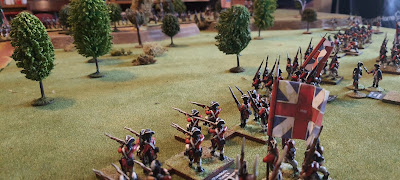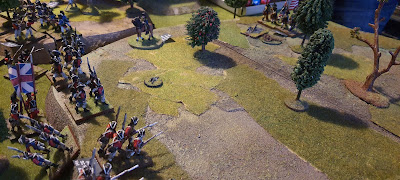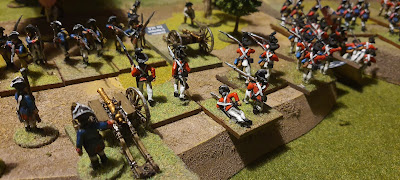We fought this relatively small battle (with Greene vs a weakened Rawdon after Guilford Court House) using the ACW rules Fire & Fury, but with online (yahoo group originally) variants for the AWI.

We've been trying a lot of AWI sets recently, though the F&F variant has some nice features:
Units are sometimes fairly big (10 or 11 stands at max, with a few 2 stand units), which means that they take up a lot of real estate on the table, but it all still works - though 25mm means a bigger table.
D10 with mods control degree of movement and rally etc.
A lot of features that we like to see as part of any AWI set:
- Movement can be difficult if out of command, but easier with good troops.
- Terrain affects a lot of things.
- Grades of unit are vitally important for almost everything - ranging from Elite, Veteran, regular down to militia grades.
In the game we saw:
- British deployed in loose order, but were effective both in giving and receiving shot.
- American numbers convinced them to charge on several occasions - all came to naught due to 'Regular' vs Veteran British
- The command D10 roll can be so bad for poor quality or disordered troops, that in the face of interpenetrating units, lesser troops like militia, simply change their minds about standing and fighting.
All in all, it is very representative of period characteristics. I think with experience comes the ability to zip through modifiers for all the players - which was the only thing that slowed us a bit - but that's no real issue.
Yes, it's more AWI in a sea of recent AWI games, but we're a little obsessed. Next game will probably entail a subtle change of pace.

 |
| The battlefield, smaller than usual, but big, fat units |
 |
| British in loose order advance toward the ridgeline |
 |
| A lot of Americans |
 |
| First musketry starts to go off |
 |
| Early cavalry action on the British right, hurts the Americans, but the British breakthrough charge leaves it broken |
 |
| The fight for the centre |
 |
| On the British left, two stands of troops manage to hold off a continental charge... |
 |
| The American centre also starts to fold |
 |
| Highly mobile British units engage to open a flank |
 |
| The flank is open |
 |
| British troops hold on the left and assault on the right and in the centre |
 |
| Flank wide open |
 |
| American units suffer from poor command rolls, and the threat on the British left subsides, drifts, then melts away |
 |
| Here they come lads!! |
 |
| Americans start to be pushed back as British troops pile on the pressure |
 |
| The British left - suddenly secure as Americans pull back |
 |
| The centre |
 |
The right, where a British breakthrough brings an end to proceedings.
Nice rules for the period and definitely work. |

































Good looking game which had some ebbs and flows to the action.
ReplyDeleteThanks Peter - yes for a relatively small action it was pretty intense, certainly no drifting off or loss of concentration as there might be in a larger game.
DeleteI like seeing battles fought with a variety of rules. Even better if the same battle is refought using different rules of engagement.
ReplyDeleteMy recent 1859 San Martino battle used another of my variations to FoH that we used in our AWI game. I thought it worked well.
Thanks Jonathan.
DeleteThe thing I've noticed for AWI though (which we already knew I guess) is that there is such a disparity between small and large battles of the period (let's say Hobkirk's and Brandywine for instance) that we are forced to look at disparate sets of rules in order to cope. Now, Volley & Bayonet did look at different scales (wing vs Brigade for example) in the same set which catered for this , but we don't have many V&B fans in the group either (except me ) :)
The advantage of FoH is that you can zoom in and out with just a few rules hacks. It would be nice to try FoH for an entire Brandywine game, or a very large C18th battle with multiple players.